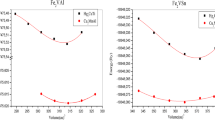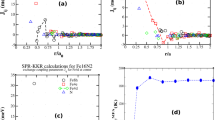Abstract
Using the Heyd–Scuseria–Ernzerhof hybrid functional method, we present a systematic study on the electronic and magnetic properties of Fe-doped antimonene. One and two Fe substitutions in an 8 × 8 supercell of antimonene are examined, and the thermodynamic and kinetic stability of Fe dopants in antimonene is thoroughly addressed. Results show that with a single Fe dopant in antimonene, the spins on the dopant are parallel to the induced spins on the surrounding Sb atoms via the hybridization between Sb 5p and Fe 3d orbitals, giving rise to ferromagnetism. Two Fe dopants in antimonene tend to stay at the substitutional sites next nearest to each other via the strong attraction, leading to the formation of the Fe-Sb-Fe cluster. With such a cluster, apart from the p-d hybridization between Fe and the surrounding Sb atoms (like the case of a single Fe dopant), two Fe atoms are found to couple ferromagnetically to each other via the mediation of the common nearest Sb atom. The ferromagnetic mechanisms between two Fe dopants are discussed and analyzed. This work offers useful theoretical guidance for promoting the applications of antimonene to spintronics.







Similar content being viewed by others
References
H.S. Tsai, C.W. Chen, C.H. Hsiao, H. Ouyang, and J.H. Liang, The advent of multilayer antimonene nanoribbons with room temperature orange light emission. Chem. Commun. 52, 8409 (2016).
Y. Wang, P. Huang, M. Ye, R. Quhe, Y. Pan, H. Zhang, H. Zhong, J. Shi, and J. Lu, Many-body effect, carrier mobility, and device performance of hexagonal arsenene and antimonene. Chem. Mater. 29, 2191 (2017).
E. Martínez-Perinan, M.P. Down, C. Gibaja, E. Lorenzo, F. Zamora, and C.E. Banks, Antimonene: a novel 2D nanomaterial for supercapacitor applications. Adv. Energy Mater. 8, 1702606 (2018).
W. Tian, S. Zhang, C. Huo, D. Zhu, Q. Li, L. Wang, X. Ren, L. Xie, S. Guo, and P.K. Chu, Few-layer antimonene: anisotropic expansion and reversible crystalline-phase evolution enable large-capacity and long-life Na-ion batteries. ACS Nano 12, 1887 (2018).
C. Gibaja, M. Assebban, I. Torres, M. Fickert, R. Sanchis-Gual, I. Brotons, W.S. Paz, J.J. Palacios, E.G. Michel, and G. Abellan, Liquid phase exfoliation of antimonene: systematic optimization, characterization and electrocatalytic properties. J. Mater. Chem. A 7, 22475 (2019).
C.X. Xiao, H.R. Hu, Y.Y. Wu, X.Y. Ren, Q.Q. Li, G.H. Yang, Z.P. Dun, Y. Huang, and F. Yan. Peng, Antimonene-based flexible photodetector. Nanoscale Horiz. 5, 124 (2020).
D. Singh, S.K. Gupta, Y. Sonvane, and I. Lukacevic, Antimonene: a monolayer material for ultraviolet optical nanodevices. J. Mater. Chem. C 4, 6386 (2016).
Y. Song, Z. Liang, X. Jiang, Y. Chen, Z. Li, L. Lu, Y. Ge, K. Wang, J. Zheng, and S. Lu, Few-layer antimonene decorated microfiber: ultra-short pulse generation and all-optical thresholding with enhanced long term stability. 2D Mater. 4, 045010 (2017).
M. Pumera and Z. Sofer, 2D monoelemental arsenene, antimonene, and bismuthene: beyond black phosphorus. Adv. Mater. 29, 1605299 (2017).
P. Ares, J.J. Palacios, G. Abellan, J. Gomez-Herrero, and F. Zamora, Recent progress on antimonene: a new bidimensional material. Adv. Mater. 11, 1703771 (2018).
S. Zhang, M. Xie, F. Li, Z. Yan, Y. Li, E. Kan, W. Liu, Z. Chen, and H. Zeng, Semiconducting group 15 monolayers: a broad range of band gaps and high carrier mobilities. Angew. Chem. Int. Ed. 55, 1666 (2016).
S. Zhang, Z. Yan, Y. Li, Z. Chen, and H. Zeng, Atomically thin arsenene and antimonene: semimetal–semiconductor and indirect-direct band-gap transitions. Angew. Chem. Int. Ed. 54, 3112 (2015).
S.K. Gupta, Y. Sonvane, G. Wang, and R. Pandey, Size and edge roughness effects on thermal conductivity of pristine antimonene allotropes. Chem. Phys. Lett. 641, 169 (2015).
G. Pizzi, M. Gibertini, E. Dib, N. Marzari, G. Iannaccone, and G. Fiori, Performance of arsenene and antimonene double-gate MOSFETs from first principles. Nat. Commun. 7, 12585 (2016).
R.S. Meng, M. Cai, J.K. Jiang, Q.H. Liang, X. Sun, Q. Yang, C.J. Tan, and X.P. Chen, First principles investigation of small molecules adsorption on antimonene. IEEE Electron Device Lett. 38, 134 (2017).
O.U. Akturk, V.O. Ozcelik, and S. Ciraci, Single-layer crystalline phases of antimony: antimonenes. Phys. Rev. B 91, 235446 (2015).
L.F. Yang, Y. Song, W.B. Mi, and X.C. Wang, Prediction of spin-dependent electronic structure in 3d-transition-metal doped antimonene. Appl. Phys. Lett. 109, 022103 (2016).
C. He, M. Cheng, and W.X. Zhang, Tunable electronic and magnetic properties of transition metals doped antimonene: a first-principles study. Mater. Res. Express 5, 065059 (2018).
X. Han, M. Benkraouda, Z. Wang, Z. Zhang, and N. Amrane, Theoretical insights into the interplay between Sb vacancy and Fe on magnetic and optoelectronic properties of Fe-doped antimonene. Chem. Phys. 576, 112107 (2024).
S. Dai, Y.L. Lu, and P. Wu, Tuning electronic, magnetic and optical properties of Cr-doped antimonene via biaxial strain engineering. Appl. Surf. Sci. 463, 492 (2019).
H. Zou, H. Zhang, Z.X. Yang, and Z.H. Zhang, Magneto-electronic and spin transport properties of transition metal doped antimonene nanoribbons. Phys. E 126, 114408 (2021).
M. Zhang, H. Guo, J. Lv, and H. Wu, Electronic and magnetic properties of 5d transition metal substitution doping monolayer antimonene: within GGA and GGA+ U framework. Appl. Surf. Sci. 508, 145197 (2020).
G. Kresse and J. Hafner, Ab initio molecular dynamics for liquid metals. Phys. Rev. B 47, 558 (1993).
G. Kresse and J. Hafner, Ab initio molecular-dynamics simulation of the liquid-metal–amorphous-semiconductor transition in germanium. Phys. Rev. B 49, 14251 (1994).
P.E. Blochl, Projector augmented-wave method. Phys. Rev. B 50, 17953 (1994).
G. Kresse and D. Joubert, From ultrasoft pseudopotentials to the projector augmented-wave method. Phys. Rev. B 59, 1758 (1999).
J. Heyd, G.E. Scuseria, and M. Ernzerhof, Erratum: “hybrid functionals based on a screened coulomb potential.” J. Chem. Phys. 124, 219906 (2006).
J.P. Perdew, K. Burke, and M. Ernzerhof, Generalized gradient approximation made simple. Phys. Rev. Lett. 77, 3865 (1996).
S. Grimme, J. Antony, S. Ehrlich, and S. Krieg, A consistent and accurate ab initio parametrization of density functional dispersion correction (DFT-D) for the 94 elements H-Pu. J. Chem. Phys. 132, 154104 (2010).
S. Grimme, S. Ehrlich, and L. Goerigk, Effect of the damping function in dispersion corrected density functional theory. J. Comput. Chem. 32, 1456 (2011).
Y. Zhou, G. Cheng, and J. Li, Coexistence of Co doping and strain on arsenene and antimonene: tunable magnetism and half-metallic behavior. RSC Adv. 8, 1320 (2018).
X. Chen, Q. Yang, R. Meng, J. Jiang, Q. Liang, C. Tan, and X. Sun, The electronic and optical properties of novel germanene and antimonene heterostructures. J. Mater. Chem. C 4, 5434 (2016).
X. Han, M. Benkraouda, and N. Amrane, S vacancy enhanced ferromagnetism in Mn-doped monolayer MoS2: a hybrid functional study. Chem. Phys. 541, 111043 (2021).
A.N. Andriotis and M. Menon, Tunable magnetic properties of transition metal doped MoS2. Phys. Rev. B 90, 125304 (2014).
X. Han, M. Benkraouda, N. Qamhieh, and N. Amrane, Understanding ferromagnetism in Ni-doped MoS2 monolayer from first principles. Chem. Phys. 528, 110501 (2020).
J.P. Buban, H. Iddle, and S. Ogut, Structural and electronic properties of oxygen vacancies in cubic and antiferrodistortive phases of SrTiO3. Phys. Rev. B 69, 180102 (2004).
C. Zener, Interaction between the shells in the transition metals. Phys. Rev. 81, 440 (1951).
C. Zener, Interaction between the shells in the transition metals. III. Calculation of the Weiss factors in Fe Co, and Ni. Phys. Rev. 83, 299 (1951).
M. Dobrowolska, K. Tivakornsasithorn, X. Liu, J.K. Furdyna, M. Berciu, K.M. Yu, and W. Walukiewicz, Controlling the curie temperature in (Ga, Mn) as through location of the fermi level within the impurity band. Nat. Mater. 11, 444 (2012).
S. Sanvito, P. Ordejón, and N.A. Hill, First-principles study of the origin and nature of ferromagnetism in Ga1–xMnxAs. Phys. Rev. B 63, 165206 (2001).
P. Mahadevan, A. Zunger, and D.D. Sarma, Unusual directional dependence of exchange energies in GaAs diluted with Mn: is the RKKY description relevant? Phys. Rev. Lett. 93, 177201 (2004).
C. Zener, Interaction between the shells in the transition metals. II. Ferromagnetic compounds of manganese with perovskite structure. Phys. Rev. 82, 403 (1951).
A.N. Andriotis and M. Menon, Successive spin polarization contribution to the magnetic coupling in diluted magnetic semiconductors: a quantitative verification. J. Magn. Magn. Mater. 501, 166313 (2020).
X. Han, N. Amrane, Z. Zhang, and M. Benkraouda, Oxygen vacancy ordering and electron localization in CeO2: hybrid Functional Study. J. Phys. Chem. C 120, 13325 (2016).
G. Henkelman and H. Jonsson, A climbing image nudged elastic band method for finding saddle points and minimum energy paths. J. Chem. Phys. 113, 9901 (2000).
G. Henkelman and H. Jonsson, Improved tangent estimate in the nudged elastic band method for finding minimum energy paths and saddle points. J. Chem. Phys. 113, 9978 (2000).
Acknowledgments
We acknowledge grants from the United Arab Emirates University Program for Advanced Research (Grant Nos: 12S096, 31R146, and G00003267) and from North University of China through the Key R&D Plans of Shanxi Province (Grant No. 201803D421084).
Author information
Authors and Affiliations
Corresponding author
Ethics declarations
Conflict of interest
The authors declare that they have no conflict of interest.
Additional information
Publisher's Note
Springer Nature remains neutral with regard to jurisdictional claims in published maps and institutional affiliations.
Rights and permissions
Springer Nature or its licensor (e.g. a society or other partner) holds exclusive rights to this article under a publishing agreement with the author(s) or other rightsholder(s); author self-archiving of the accepted manuscript version of this article is solely governed by the terms of such publishing agreement and applicable law.
About this article
Cite this article
Han, X., Benkraouda, M., Zhang, Z. et al. Theoretical Perspective of Fe-Induced Ferromagnetism in Antimonene: A Hybrid Functional Study. J. Electron. Mater. 53, 1816–1822 (2024). https://doi.org/10.1007/s11664-024-10949-6
Received:
Accepted:
Published:
Issue Date:
DOI: https://doi.org/10.1007/s11664-024-10949-6




